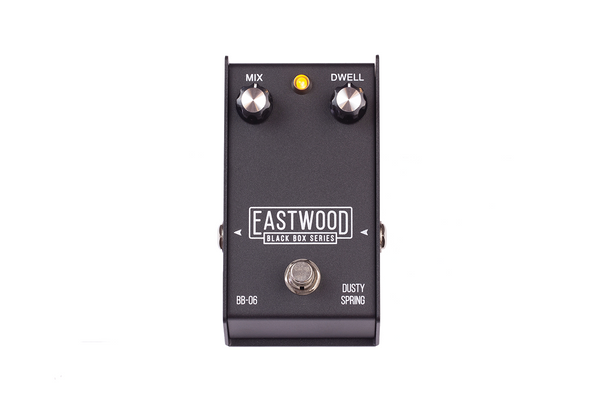If, like many of us, you hail from a style-minded and vintage-oriented but budget-constrained segment of the populace, you’re probably grateful that Eastwood Guitars exists. Though the company’s offerings tend to favor the obscure, Eastwood is good at building functionally unique, well-made, and practical homages to weirdo styling. I know players who make Eastwood instruments front-line, first-choice guitars as much for their unique sound and feel as their looks.
Given their history, it’s easy to be tantalized by Eastwood’s new guitar-pedal endeavors. The new Black Box series may forego the flash that one associates with the brand. But they use much-loved vintage touchstones as a jumping-off point. And the uniform, utilitarian appearance of the pedals (which fits nicely with a certain branch of vintage-pedal aesthetics, if you think about it) helps Eastwood achieve more approachable pricing—another pillar of the company’s ethos. The Dusty Spring reverb, with its two knobs and very straight-ahead functionality, is an especially fine embodiment of the Black Box Series’ substance-before-style philosophy.
Sprung From the Cage
Digital approximations of spring reverb have always been tough to execute. For starters, the mechanical, clanging, and metallic overtones of a spring reverb are tough to reproduce in digital formats that aren’t high-horsepower, number-crunching DSP applications. Further, “authentic” spring reverb can be a lot of things. Even if you’re a Fender reverb purist, the spring in, say, a black-panel Vibrolux can sound pretty different from that in an outboard Fender Reverb. And that’s before considering the differences between those units and a Space Echo’s awesome spring sounds, or a Bandive Great British Spring, or a Grampian—or, for that matter, two different Fender Vibroluxes. As with most things music related, I take a very liberal view of what constitutes the “best” spring-reverb sound, so I didn’t listen for a spot-on Fender reproduction in the Dusty Spring. I’m glad, because what I heard is a spring-reverb approximation that sounds great on its own merits while delivering a lot of what any player—Fender fans included—would want from an affordable digital spring reverb.
Pinging and Swinging
The Dusty Spring’s economical layout—there are just controls for wet/dry mix and dwell, which is essentially decay time—means it’s very easy and intuitive to move between pretty disparate sounds. Such simplicity can feel like a gift from the gods if you have a busy pedalboard or want to make changes in the heat of a set. But what makes that simplicity doubly satisfying here is that both ends of the Dusty Spring’s range produce tasty takes on spring-reverb flavor.
Such simplicity can feel like a gift from the gods if you have a busy pedalboard or want to make changes in the heat of set.
More subdued settings are soft around the edges while retaining the ghostly, nostalgic sense of space that gives spring reverb its emotional tug. It’s a cool balance when you find it. Splashier and more extreme settings are super fun as well. The Dusty Spring probably resides narrowly on the slightly brighter side of the spring-sound spectrum (again, it’s a very broad category), and that makes the effect quite lively. It might also accentuate the hard, almost pulsing reflections that spring reverbs and digital spring emulations usually produce, which come on at relatively lower dwell settings here. No matter how right or wrong that may sound to your ears on its own, it sounded great in the context of small-ensemble playing, where the percolating reverberations added a dose of kinetic energy.
The Verdict
The Dusty Spring is aptly named. There’s an earthiness to the pedal in the way it sticks to spring-style sounds without trying to get too celestial, which often equates to sounding too digital. There are audible trace elements of digital artifacts at the wettest, most ambient settings when heard in isolation. Then again, a spring reverb can produce its own strange overtones at the advanced settings, some of which won’t sound quintessentially Joe Meek- or Dick Dale-style either. The streamlined controls are authentically old-school and provide a useful creative-decision constraint without significantly diminishing the breadth of tones. There are reverbs that do more in the Dusty Spring’s vaguely-$150 price range. But few offer such a nice cross of elegant simplicity and vintage-patina’d tones.


















